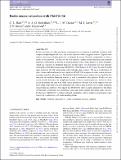Files in this item
Radio source extraction with ProFound
Item metadata
| dc.contributor.author | Hale, C. L. | |
| dc.contributor.author | Robotham, A. S. G. | |
| dc.contributor.author | Davies, L. J. M. | |
| dc.contributor.author | Jarvis, M. J. | |
| dc.contributor.author | Driver, S. P. | |
| dc.contributor.author | Heywood, I. | |
| dc.date.accessioned | 2019-06-26T14:30:07Z | |
| dc.date.available | 2019-06-26T14:30:07Z | |
| dc.date.issued | 2019-08 | |
| dc.identifier | 259378985 | |
| dc.identifier | b0d5e6ba-6eeb-4a1e-8af9-e6ebaf465e6c | |
| dc.identifier | 85072301023 | |
| dc.identifier.citation | Hale , C L , Robotham , A S G , Davies , L J M , Jarvis , M J , Driver , S P & Heywood , I 2019 , ' Radio source extraction with ProFound ' , Monthly Notices of the Royal Astronomical Society , vol. 487 , no. 3 , pp. 3971–3989 . https://doi.org/10.1093/mnras/stz1462 | en |
| dc.identifier.issn | 0035-8711 | |
| dc.identifier.other | ArXiv: http://arxiv.org/abs/1902.01440v2 | |
| dc.identifier.uri | https://hdl.handle.net/10023/17971 | |
| dc.description.abstract | In the current era of radio astronomy, continuum surveys observe a multitude of objects with complex morphologies and sizes, and are not limited to observing point sources. Typical radio source extraction software generates catalogues by using Gaussian components to form a model of the emission. This may not be well suited to complicated jet structures and extended emission, particularly in the era of interferometers with a high density of short baselines, which are sensitive to extended emission. In this paper, we investigate how the optically motivated source detection package ProFound (Robotham et al. 2018) may be used to model radio emission of both complicated and point-like radio sources. We use a combination of observations and simulations to investigate how ProFound compares to other source extractor packages used for radio surveys. We find that ProFound can accurately recover both the flux densities of simulated Gaussian sources as well as extended radio galaxies. ProFound can create models that trace the complicated nature of these extended galaxies, which we show is not necessarily the case with other source extraction software. Our work suggests that our knowledge of the emission from extended radio objects may be both over or under-estimated using traditional software. We suggest that ProFound offers a useful alternative to the fitting of Gaussian components for generating catalogues from current and future radio surveys. Furthermore, ProFound’s multiwavelength capabilities will be useful in investigating radio sources in combination with multiwavelength data. | |
| dc.format.extent | 10781047 | |
| dc.language.iso | eng | |
| dc.relation.ispartof | Monthly Notices of the Royal Astronomical Society | en |
| dc.subject | Methods: data analysis | en |
| dc.subject | Radio-continuum: galaxies, general | en |
| dc.subject | QB Astronomy | en |
| dc.subject | QC Physics | en |
| dc.subject | NDAS | en |
| dc.subject.lcc | QB | en |
| dc.subject.lcc | QC | en |
| dc.title | Radio source extraction with ProFound | en |
| dc.type | Journal article | en |
| dc.contributor.institution | University of St Andrews. School of Physics and Astronomy | en |
| dc.identifier.doi | 10.1093/mnras/stz1462 | |
| dc.description.status | Peer reviewed | en |
This item appears in the following Collection(s)
Items in the St Andrews Research Repository are protected by copyright, with all rights reserved, unless otherwise indicated.

